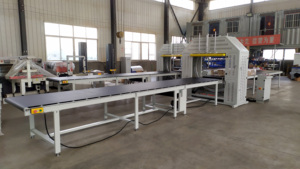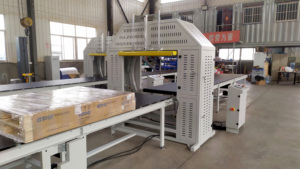
All categories
Featured selections
Trade Assurance
Buyer Central
Help Center
Get the app
Become a supplier

(1602 products available)



























Manufacturers produce pallet wrap making machines to make pallet wrap; the machines are usually divided into two groups based on the process and the end product.
While the wraps mentioned above are suited for retail, the polypropylene (PP) film is preferred in the industrial sector. It has coiling capabilities and massive production line capacities. Additionally, it is more economical when producing large quantities of wraps.
The specifications of pallet wrap manufacturing machines are usually described according to the model or type. The following are some general specifications corresponding to the types discussed above.
Taking proper care of a pallet wrap film-making machine ensures it performs well, lasts longer, and reduces downtime. Manufacturers suggest a maintenance schedule to enhance the machine's efficiency and ensure production runs smoothly. Here are a few recommended maintenance tips:
Pallet wrap making machines have widespread applications in warehouses and logistics centers for efficient pallet packing. They are used to stabilize goods stacked on pallets during transportation and storage. Moreover, pallet wrap machines are utilized in the furniture manufacturing industry to prevent damage and contamination to the products. They also find usage in the glass and ceramics industry to provide cushioning and shatterproof packaging for delicate and fragile items. Furthermore, pallet wrap machines are widely used in the food and beverage industry to increase shelf life, preserve quality, and protect perishable products.
In addition, pallet wrap machines are helpful in the construction and home improvement industry to securely wrap and protect tools, equipment, and materials. They are also used in the retail industry for over 50% of shrink wrap production, especially for packaging and securing merchandise, including electronic and textile products. Moreover, pallet wrap machines are helpful in the automotive industry to protect vehicle parts, accessories, and assemblies from dust, moisture, and damage during transit and storage.
Pallet wrap machines are economical and efficient packaging solutions for books, boxes, and other non-palletized items in the stationery and packaging industry. They are also helpful in the pharmaceutical and personal care industries to provide tamper-evident and contamination-free packaging for medicines, cosmetics, and personal care products. Moreover, they are valuable tools for exhibition organizers and event planners to package and transport display materials, equipment, and supplies safely.
Furthermore, e-commerce businesses, including online retail platforms and logistics providers, rely on pallet wrap machines to securely package and wrap products for delivery to customers. They are also essential tools for moving and storage companies to securely wrap and protect items, furniture, and equipment during transportation and storage. Additionally, pallet wrap machines are valuable in the frozen food and cold storage industry to provide temperature-controlled and secure packaging for perishable goods.
When investing in a machine for making pallet wraps, several factors need to be considered before going for any particular type. These include the construction material for the machine, the level of automation, the production capacity it offers, as well as the core sizes of pallet wraps it can handle.
The construction material of the machine can impact both its weight and the strength of the pallets it produces. Materials like high-strength steel or aluminum are commonly used. Such heavy-duty materials guarantee stability during operation and ensure product longevity even under regular use.
Manufacturers offer wrap-making machines with different levels of automation to suit diverse market demands. Automated machines with touch screens ensure efficient production but require a higher initial investment and may cost more to maintain. On the other hand, semi-automatic machines need less manpower than fully manual ones and still provide reasonable production rates. Consider the cost of electricity before investing in an automated machine.
Higher production capacities come at a price. Standard midday and night production capacities of over 2,000 pallets are expectable for fully-automated production lines. In contrast, semi-automatic and manual setups would have more manageable production rates of around 200–500 pallets at max per day. So, know the business needs better to choose between high and low production capacities.
The core size of the pallet wraps the machine can handle limits the kind of customer base a manufacturer can have. If large commercial businesses are the target audience, then machines with core sizes of more than 3 inches would be necessary. Conversely, smaller core sizes would limit one's reach to small businesses only.
Q1: What are the trends in the global pallet wrap market?
A1: The global pallet wrap market is expected to witness a stable growth rate in the forecast period. E-commerce and retail sectors are experiencing strong growth, increasing demand for packaging solutions to protect goods during transport and storage. There is a rising awareness of sustainable packaging materials among businesses and consumers, driving the demand for recyclable and biodegradable pallet wraps. Innovations in packaging materials and technologies are creating opportunities for the pallet wrap market.
Q2: What is the future of stretch film?
A2: The future of stretch film looks promising. The demand for stretch film is expected to remain strong in the coming years. Stretch film manufacturers are focusing on developing films with specific properties tailored to end-users' needs. Demand for environmentally friendly packaging solutions is growing; therefore, stretch film made of recycled plastic is gaining popularity.
Q3: What is the impact of automated pallet wrapping machine on the market?
A3: The development of automated pallet wrapping machines has changed how items are wrapped and packaged. Due to its time savings, increased output, and superior wrapping quality, automated machines are preferred over manual wrapping techniques. The stretch film and automated pallet-wrapping machine market are complementary. Both markets will continue to grow together as automation becomes more popular in the packaging sector.